Intel Core i7-11700K Review: Blasting Off with Rocket Lake
by Dr. Ian Cutress on March 5, 2021 4:30 PM EST- Posted in
- CPUs
- Intel
- 14nm
- Xe-LP
- Rocket Lake
- Cypress Cove
- i7-11700K
Gaming Tests: F1 2019
The F1 racing games from Codemasters have been popular benchmarks in the tech community, mostly for ease-of-use and that they seem to take advantage of any area of a machine that might be better than another. The 2019 edition of the game features all 21 circuits on the calendar for that year, and includes a range of retro models and DLC focusing on the careers of Alain Prost and Ayrton Senna. Built on the EGO Engine 3.0, the game has been criticized similarly to most annual sports games, by not offering enough season-to-season graphical fidelity updates to make investing in the latest title worth it, however the 2019 edition revamps up the Career mode, with features such as in-season driver swaps coming into the mix. The quality of the graphics this time around is also superb, even at 4K low or 1080p Ultra.
For our test, we put Alex Albon in the Red Bull in position #20, for a dry two-lap race around Austin. We test at the following settings:
- 768p Ultra Low, 1440p Ultra Low, 4K Ultra Low, 1080p Ultra
In terms of automation, F1 2019 has an in-game benchmark that can be called from the command line, and the output file has frame times. We repeat each resolution setting for a minimum of 10 minutes, taking the averages and percentiles.
| AnandTech | Low Resolution Low Quality |
Medium Resolution Low Quality |
High Resolution Low Quality |
Medium Resolution Max Quality |
| Average FPS |  |
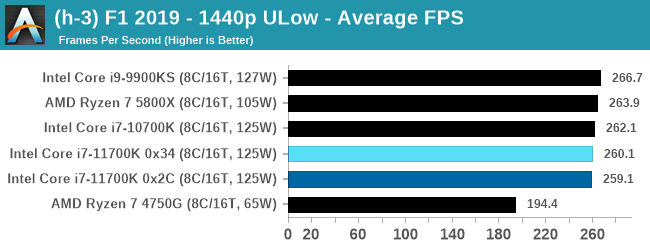 |
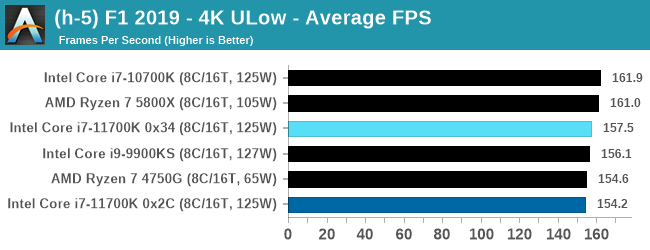 |
 |
| 95th Percentile | 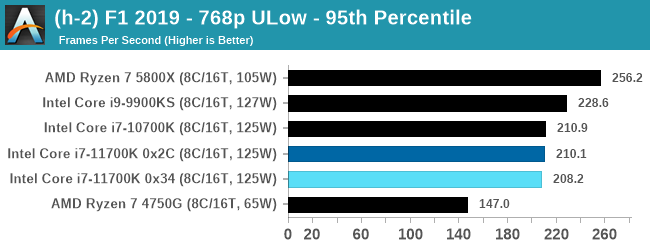 |
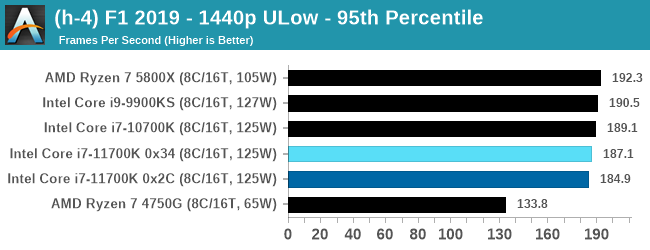 |
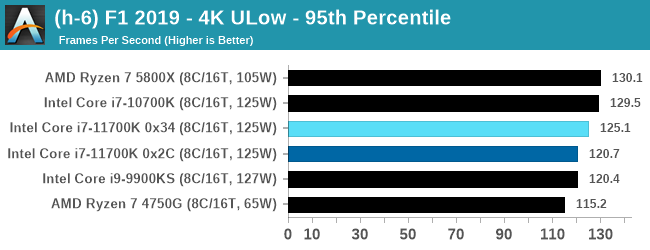 |
 |
The Ego engine is usually a good bet where cores, IPC, and frequency matters. Despite this, the 11700K isn't showing much of a generational improvement.
All of our benchmark results can also be found in our benchmark engine, Bench.












541 Comments
View All Comments
lmcd - Friday, March 5, 2021 - link
As an Intel fan, this is abysmal. This is literally only good for an i3 or i5 SKU, for its upgraded iGPU. That's it.Slash3 - Friday, March 5, 2021 - link
The 11th gen i3 SKUs will not feature the new Xe core - they are still based on Comet Lake.lmcd - Friday, March 5, 2021 - link
That makes this even sadder. This port was actually worthless. An i5 quad core might be manageable by a cooler that fits in an average case, but that's about it.Would've been better off releasing Tiger Lake 35W processors on an LGA package.
Slash3 - Friday, March 5, 2021 - link
The 6C/12T i5-11500 should be "fine," as it has the same 32CU Xe iGPU as the higher end parts. The part below it, the i5-11400, is also 6C/12T but has a cut down 24CU Xe core.The Xe upgrade is a nice change, at about a 33% uplift over the previous "Gen11" iGPU, but it's still just what I'd call "passable" for light gaming. Anything above 1080p and you'll want a discrete GPU for the best experience, and that goes for both teams.
lmcd - Friday, March 5, 2021 - link
I understand what you're saying but I still think the 6-core i5 is going to draw a boatload of power.Obviously for gaming a dGPU is preferable. In my experience with AMD's Ryzen 2400G, though, it isn't actually too stable with medium resolution monitor configurations (think 1080p + 1440p) and isn't all that well supported by drivers.
On the Intel side, uplift over Gen11 is cool but uplift over Gen9 is where it gets noticeable, and important. Gen9 was fine when it came out but that was quite some time ago. Shows its age when too many apps want GPU acceleration with that same multi-monitor setup I described.
lmcd - Friday, March 5, 2021 - link
Sorry, didn't complete my thought. Anyway, point is that a decent % of Intel's sales are for business desktops (maybe not right now, but, ya know, offices might open up sometime this calendar year, before Alder Lake ships in volume). Rocket Lake i5 would be perfect, if its real-world power consumption wasn't out the roof. Good enough graphics for multi-monitor, fine performance elsewhere.I guess that makes me wonder what performance would be if limited to a 65W avg/95W peak thermal output. That's about what those small Dell towers can handle.
Slash3 - Friday, March 5, 2021 - link
Yep, I'm with you.I honestly don't expect the i5 models to have the same outlandish power usage characteristics as the reviewed i7, but will definitely be reading any day one reviews that may pop up. The existing i5-10400 is a pretty compelling product (and priced well), and if the 11400 or 11500 can manage to fit into the same ~100W PL2 envelope I think it'll find a home in a lot of desktops. For OEMs, they're sometimes board limited to the 65W PL1 via a BIOS option, and I'd expect that to continue with the 11th gen versions.
If they price the 11400 close to the 10400, it'll be a solid choice.
Makaveli - Friday, March 5, 2021 - link
The Turbo for the 5800X should be 4850 that is what I see at stock. So the table is off by 50mhzSaturnusDK - Saturday, March 6, 2021 - link
Not really. AMD changed the way they report boost frequency numbers. Before it was "up to xxxxMHz boost", now it's the more wordy "given adequate cooling the boost frequency is _at least_ xxxxMHz". This change was driven by the stick they got for the 3000-series only very rarely hitting the listed boost frequency. Now you can generally assume to get 50-100MHz _above_ the listed boost frequency if you have a half-decent cooler.Marlin1975 - Friday, March 5, 2021 - link
WTF!!! 291 watts?!?!?Intel REALLY needs to step up is manufacture game. Designs seem ok but the nodes are killing them.